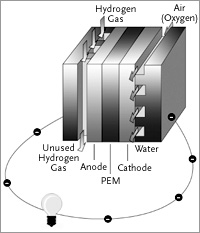

|
|
Think of them as big batteries, but ones that only operate when fuel—in this case, pure hydrogen—is supplied to them. When it is, an electrochemical reaction takes place between the hydrogen and oxygen that directly converts chemical energy into electrical energy. Various types of fuel cells exist, but the one automakers are primarily focusing on for fuel cell cars is one that relies on a proton-exchange membrane, or PEM. In the generic PEM fuel cell pictured at left, the membrane lies sandwiched between a positively charged electrode (the cathode) and a negatively charged electrode (the anode). In the simple reaction that occurs here rests the hope of engineers, policymakers, and ordinary citizens that someday we'll drive entirely pollution-free cars. (For more on the likelihood and timing of this, see Point-Counterpoint or ask our expert.) Here's what happens in the fuel cell: When hydrogen gas pumped from the fuel tanks arrives at the anode, which is made of platinum, the platinum catalyzes a reaction that ionizes the gas. Ionization breaks the hydrogen atom down into its positive ions (hydrogen protons) and negative ions (electrons). Both types of ions are naturally drawn to the cathode situated on the other side of the membrane, but only the protons can pass through the membrane (hence the name "proton-exchange"). The electrons are forced to go around the PEM, and along the way they are shunted through a circuit, generating the electricity that runs the car's systems. Using the two different routes, the hydrogen protons and the electrons quickly reach the cathode. While hydrogen is fed to the anode, oxygen is fed to the cathode, where a catalyst creates oxygen ions. The arriving hydrogen protons and electrons bond with these oxygen ions, creating the two "waste products" of the reaction—water vapor and heat. Some of the water vapor gets recycled for use in humidification, and the rest drips out of the tailpipe as "exhaust." This cycle proceeds continuously as long as the car is powered up and in motion; when it's idling, output from the fuel cell is shut off to conserve fuel, and the ultracapacitor takes over to power air conditioning and other components. A single hydrogen fuel cell delivers a low voltage, so manufacturers "stack" fuel cells together in a series, as in a dry-cell battery. The more layers, the higher the voltage. Electrical current, meanwhile, has to do with surface area. The greater the surface area of the electrodes, the greater the current. One of the great challenges automakers face is how to increase electrical output (voltage times current) to the point where consumers get the power and distance they're accustomed to while also economizing space in the tight confines of an automobile.—Peter Tyson
To see how a hydrogen fuel cell powers an automobile, go to the
clickable car.
|
||||||||||
|
© | Created July 2005 |
|||||||||||
